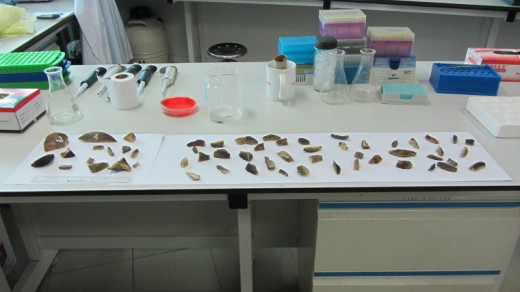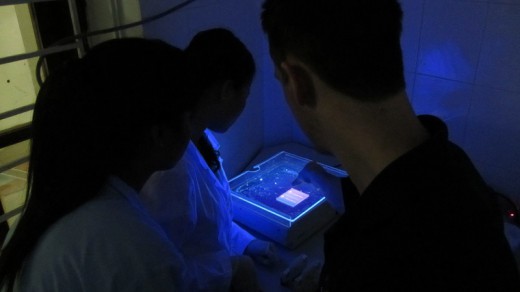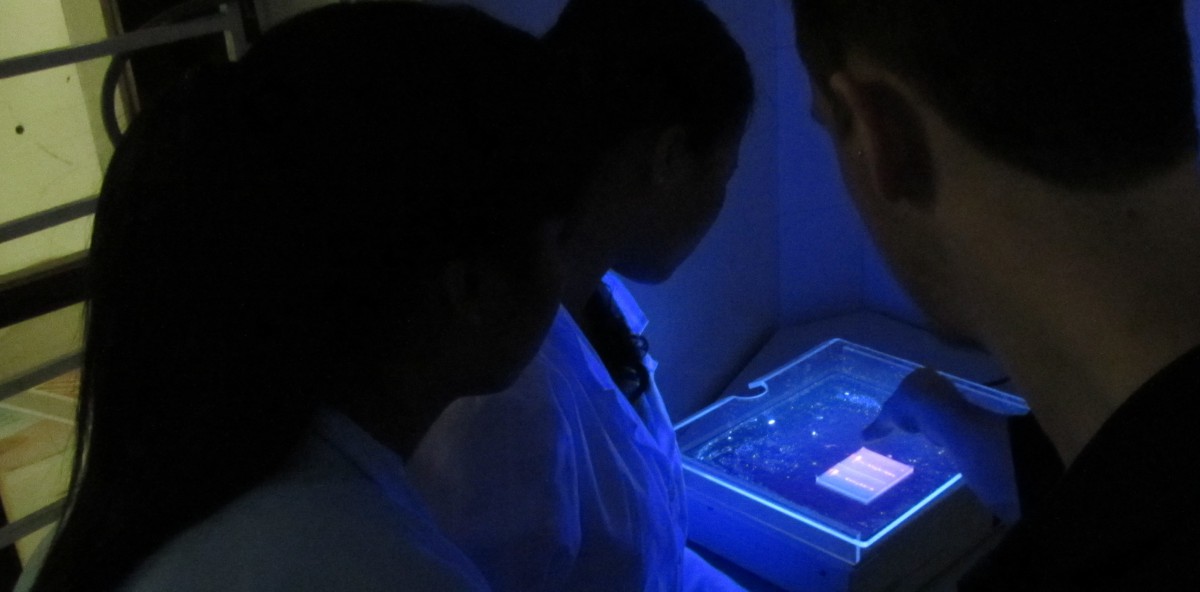- The illegal trade in rhino horn is devastating remaining rhino populations
- When horns are seized in Vietnam, procedural hurdles and a lack of forensic proficiency contribute to low rates of criminal prosecutions
- A recent training equipped technicians with a rapid and inexpensive technique to provide DNA evidence for criminal trials.
Fighting the illegal rhino horn trade can be a race against time — in more ways than one.
As poachers slaughter rhinos at an alarming rate (more than 700 rhinos were killed in South Africa alone this year), governments and other organizations are scrambling to stop the carnage. And on the other end of the supply chain, time is of the essence when customs officers seize rhino horns in Vietnam, one of the world’s top consumers of rhino horn. Because a suspect can only be held without charges for 48 hours in Vietnam, officials must quickly determine the horns’ authenticity for a criminal investigation to proceed.
Now, thanks to a training funded by the UK Government, the Royal Zoological Society of Scotland (RZSS) and the Australian Museum, technicians at the Institute of Ecology and Biological Resources (IEBR) wildlife genetics lab have a new tool in their arsenal: a rapid technique for testing DNA and proving seized horns’ authenticity.
Big Business and a high bar for evidence
The rhino horn trade is booming in Vietnam — law enforcement officials there have been known to seize hundreds of horns at a time, according to Ross McEwing, of RZSS and the TRACE Wildlife Forensics Network. The horns can fetch astronomical prices on the black market, as high as $100,000/kg, as they are thought to cure cancer, suppress hangovers, and — because of their high price — confer a certain luxurious cachet.
The high demand and higher prices have contributed to a surge in rhino poaching in recent years.

“We’re at a tipping point for rhino with the number of poached individuals coming precariously close to outnumbering the birth rate, a position that will ultimately lead to the decline and possible loss of these enigmatic species,” Rebecca Johnson, director of the Australian Museum Research Institute and Australian Centre for Wildlife Genomics , said in a press release.
When customs agents seize illegal rhino horns, it often makes a splash in the media, McEwing said, but it’s rare for a prosecution to follow. And given how lucrative the trade in rhino horns is, unless the kingpins and middlemen are placed behind bars, a few seizures won’t make much difference.
But when using DNA as evidence in wildlife crime, the process of gathering that evidence must be held to the same high standard as if it were human DNA evidence gathered from a crime such as rape or murder.
“We need to do things in a very rigorous and robust way,” McEwing said. “We can’t drop the bar just because it’s wildlife.”
McEwing and the technicians in the IEBR lab who use their expertise to identify illegal animal products face well-funded and proficient nemeses: McEwing said they have sinister doppelgängers adept at identifying animal products for more nefarious purposes.
“They’re very knowledgeable about what the real stuff looks like,” McEwing said. “There’s a kind of parallel expertise in wildlife forensics in terms of morphological identification of things for people [traffickers and consumers] who want to verify a product.”
A quick test
Around the world, technicians already have the tools to prove the authenticity of rhino horn, but the tests are relatively slow, expensive and were unavailable in Vietnam.
When McEwing heard that some scientists at the Australian Centre for Wildlife Genomics had developed a rapid test for rhino horn DNA, he thought it’d be a great tool in Vietnam. So he organized a training session: McEwing, Greta Frankham and Kyle Ewart, both from the Australian Museum Research Institute, spent a week teaching the technique to the technicians at the IEBR.

The rapid rhino DNA test is actually two tests in one: a presumptive test and a definitive test.
“It’s kind of like if you’re drinking alcohol, and you’re stopped by the police,” McEwing said. The officer will do a preliminary presumptive test to justify taking you to the police station, where another definitive test — admissible in court — would be administered.
“That’s what we’ve tried to do in Vietnam,” McEwing said. “We’ve created a presumptive test, which is a test which allows the investigator to say beyond a reasonable doubt, ‘Yes this is actually rhino horn,’ and we can progress. And we later on follow it up with the definitive test if it’s needed.”
For the presumptive portion of the test, the technicians rely on a process called polymerase chain reaction, or PCR, which replicates snippets of an organism’s DNA. By multiplying some bits of DNA associated with rhino horn, the technicians can quickly show whether the material is, in fact, a rhino.
Then for the slower definitive test, technicians take the amplified snippets of DNA and have it sequenced. By comparing the DNA sequence in the sample against a database of many other animals’ DNA, they can prove beyond a shadow of doubt that the seized material was not only rhino horn, but horn from a particular species of rhino.

Rhino horn is composed mostly of keratin, the same durable protein found in human hair and fingernails. Isolating DNA from the horn is actually the slowest part of the new technique — breaking down a horn’s keratin to access the horn’s genetic material takes time. But once the DNA is accessible, PCR takes only about 45 minutes, McEwing said, and the whole process takes less than 24 hours.
Progress and obstacles
The training is part of a long process of capacity building in Vietnam.
“The problem is, that they have very basic lab capabilities,” McEwing said. “Over the past five years we’ve fitted them with new shelving, we’ve bricked up walls, we’ve changed the layout, we’ve got them instrumentation, we’ve trained the staff… it’s about small steps to making these labs better.”
Next, IEBR lab technicians will travel to Australia for additional training in a state-of-the-art wildlife forensics lab.
McEwing is also working on a number of other DNA-based projects that target the illegal wildlife trade in Vietnam. For example, the country is home to numerous tiger farms, or captive collections of tigers.
“We know these tigers leak out and leak into the illegal trade,” McEwing said. To track the movement of tigers from farms into the illegal wildlife trade, they’re creating a DNA database of all captive tigers in Vietnam.
The team is also preparing to implement a DNA test for pangolins, some of the most-trafficked mammals in Asia, which will help identify the particular species of pangolin and where each animal came from.
As with the rhino horns, these other tests will both facilitate prosecutions and provide intelligence.

“Organizations like Interpol are taking all these intelligence reports and putting them into computer models that find linkages between different people,” McEwing said. “Prosecuting the couriers of rhino horn does not stop the rhino horn trade. In order to stop the illegal trade, we need to target the kingpins, the middlemen. The poor guys are dispensable… there’s always some poor guy who needs to make a buck.”
“Three species of rhino are routinely traded in Vietnam – white, black and Indian rhinos – and identifying the species forms part of the investigation, helping enforcement agencies direct resources to target individuals and trade routes,” Kyle Ewart, of the Australian Museum Research Institute’s Australian Centre Wildlife Genomics, said in a press release.
And although the new technique will allow the IEBR lab to quickly test rhino horn and hopefully help build cases against wildlife traffickers, IBER and other institutions fighting wildlife trafficking face plenty of other obstacles. Mostly, McEwing said, their difficulties come down to money, not tools.
“There’s no funding for implementing the techniques that already exist. So while it’s nice to have a nice, shiny, brand new toy, in actual fact, we may not need that. We may just need some cash to make the technology we’ve got work,” McEwing said.
“The boring side after you make the splash is where you make the difference.”
